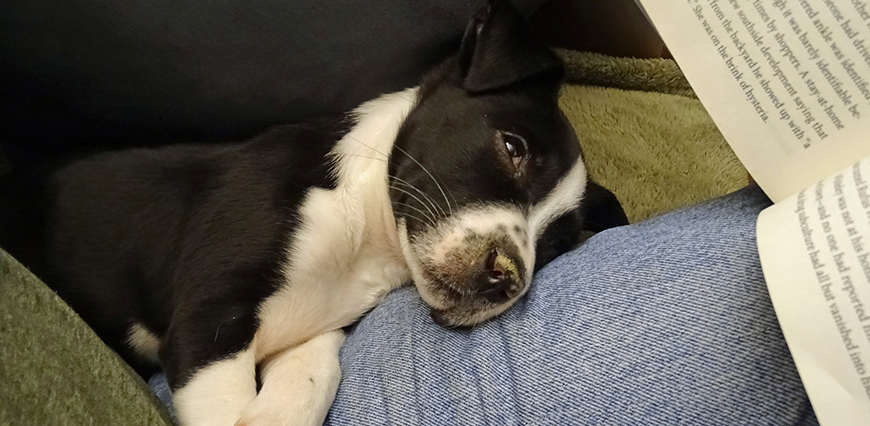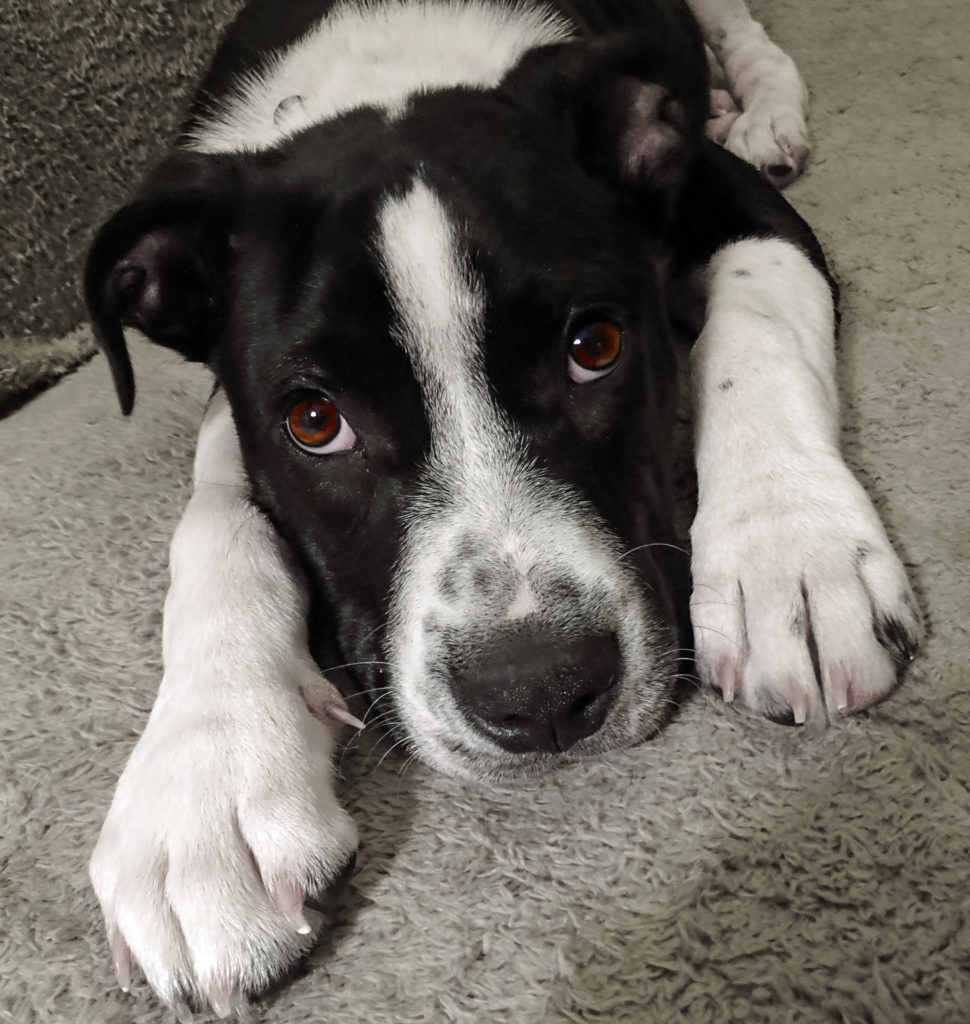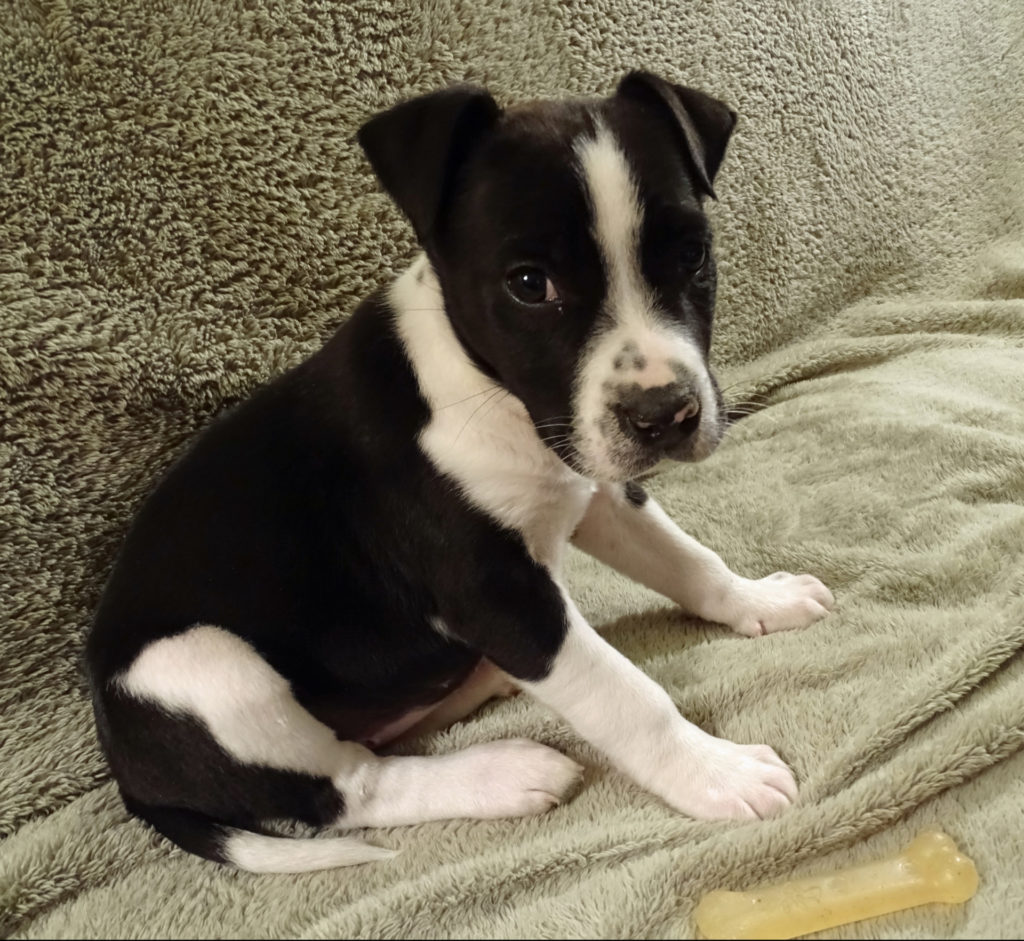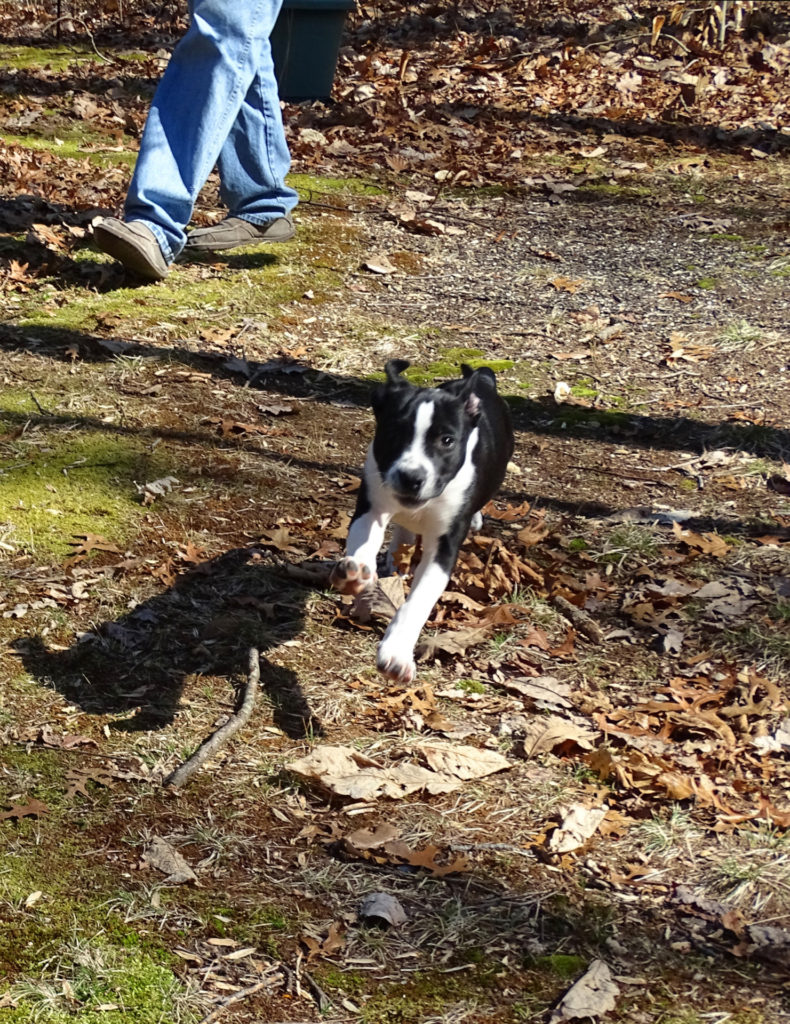
Above: Piper developed canine parvovirus infection the day after she was adopted by a couple in Maryland. (Photo courtesy of Catherine Houghton)
It was a gut-wrenching decision for a pet owner: Spend an estimated $5,000 on veterinary hospitalization for a sick puppy – adopted just one day earlier – or humanely euthanize her.
Catherine and Rob Houghton were at a loss. During 34 years of marriage, the Maryland couple always had Weimaraners and took seriously the tasks of choosing their dogs, vetting breeders, and examining puppy health. They had recently lost their last Weimaraner to congestive heart failure, after spending some $10,000 on veterinary care.
The Houghtons simply could not afford a new round of steep veterinary bills for Piper, a 7-week-old American Staffordshire Terrier mix adopted in February on a whim, without their usual scrutiny. Nor did the Houghtons have the heart to euthanize Piper, who was diagnosed with potentially deadly parvovirus one day after the couple brought her home from a rescue group.
“I started crying,” Catherine Houghton recalled. “We were not in a position to afford this. We needed another option.”
Parvo clinical trial
Dr. Lauren Sullivan is launching a second study regarding parvovirus infection in puppies. This time, she will examine a new treatment that may help improve recovery time in sick patients. Enrollment in the clinical trial is free for puppies that qualify. For information, check the CSU Clinical Trials website or email Sullivan at lauren.sullivan@colostate.edu.
That’s when their vet looked up a research paper by a group of Colorado State University veterinarians, which had just been published in the Journal of Veterinary Emergency and Critical Care. The paper demonstrated the success of a newly established treatment protocol for puppies afflicted with canine parvovirus infection.
While the gold standard of treatment is hospitalization, the CSU team showed that puppies could overcome the intestinal form of parvovirus infection if diligently treated at home with medication, fluids injected under the skin, and a special diet administered by syringe. The protocol is highly demanding for owners – requiring treatment and monitoring every few hours – but the out-of-pocket costs are a few hundred dollars compared to a few thousand for hospitalization.
Notable success with at-home treatment

The CSU team, led by Dr. Lauren Sullivan, a specialist in small-animal emergency and critical care at the James L. Voss Veterinary Teaching Hospital, studied the effectiveness of the therapy in 20 puppies that were afflicted with canine parvoviral enteritis and, after initial stabilization, were treated with the outpatient protocol. The veterinary researchers compared outpatient outcomes with outcomes for 20 puppies treated through the preferred approach of hospitalization.
Of the puppies treated with the outpatient protocol, 80 percent survived parvovirus, compared to 90 percent survival among puppies that received the in-patient hospital protocol. Zoetis funded the research.
“A big impetus for the study was, ‘How do we honor the human-animal bond when finances are an issue?’ This protocol creates a bridge. It allows us to say, ‘We can still help you and your pet.’ That has been the most meaningful part of this study,” Sullivan said. “Hospitalization is still the gold standard, and veterinary involvement is still necessary with the outpatient protocol, but this is another choice for families that are committed and have the time.”
Vaccination is the most important way to prevent parvovirus infection, and vaccination should occur at weaning, when puppies are 6 to 8 weeks old, with a minimum of two subsequent boosters. Yet countless puppies around the globe are exposed to parvovirus, often in shelter settings or in places with limited access to affordable veterinary care. As a result, parvo is the most common and lethal infectious disease in unvaccinated young dogs, often striking when puppies are younger than 6 months old.
Finding another treatment option
Symptoms of the intestinal form of parvo include vomiting, diarrhea, weight loss, and lack of appetite; dehydration is a serious secondary effect. Parvo is usually fatal if dogs are not treated.

Because of the intensity of the disease, hospitalization is recommended so that patients may receive round-the-clock intravenous medication, fluid support and medical monitoring. With this treatment, most puppies recover from parvo in a few days. Yet costs run into the thousands.
Sullivan launched the CSU study hoping to give clients another choice that was proven successful.
“Our veterinarian told us we could try this protocol with Piper, and we said, ‘OK, that’s our option,’” Houghton recalled.
Last February, Houghton, a science educator and painter, and her husband, a dog trainer, converted their kitchen counter into a treatment area for the listless puppy that wouldn’t eat. Several times a day, according to strict instructions, they administered medicine, fluids and food to their rescue puppy. For three weeks, Piper showed virtually no improvement as her 7-pound body battled the viral illness.
“Emotionally, it was very difficult because we didn’t know if she would make it,” Houghton said.
‘Last bite’ marks turning point
Then, one evening, in keeping with the couple’s dinnertime ritual, Rob Houghton offered Piper the “last bite” from dinner – in this case, a nibble of Maryland crab.
Piper perked up. She sniffed. She gobbled.

“That’s the point I thought, ‘OK, she’s going to make it.’ Once she turned the corner, the recovery was fairly rapid,” Houghton said.
During a fourth week of at-home treatment, Piper became more responsive and playful. Now, at about 5 months old, Piper weighs 53 pounds. She shreds bedding, she shreds toys, she chases squirrels and bees, she plays keep-away, she dashes in figure-eight patterns through the woods, and she maintains an incorrigible and sassy attitude – except when she’s cuddling, sleeping on the bed, or licking her lips for “last bite.”
Recovery stories surface
“I call her my ‘sturdy girl.’ She’s probably the most spoiled dog we’ve had in our entire lives,” Houghton said with a laugh. “Having her with us is priceless. The alternative was that she was going to die. I can’t imagine life without her.”
Before the parvo study was published in December 2016, CSU investigators shared their findings at two international veterinary conferences. The study also received astounding attention through a veterinary podcast and a Facebook Live presentation.
These days, recovery stories like those of Piper are surfacing through the veterinary grapevine.
“I’ve gotten calls and feedback from across the United States. The protocol is promoting itself through word of mouth because it has implications for so many people,” Sullivan said. “When a parvo puppy recovers and a family has their dog back, it’s one of the most heartwarming things in the world.”
Book sales fund research
Catherine Houghton of North East, Md., owner of Piper, self-published a picture book about her beloved dog’s first several months of life. The book is titled, “Piper No,” a reference to the rescue puppy’s naughty behavior. Houghton will donate 20 percent of book profits to support parvovirus research at CSU’s James L. Voss Veterinary Teaching Hospital. The book is available through Amazon.